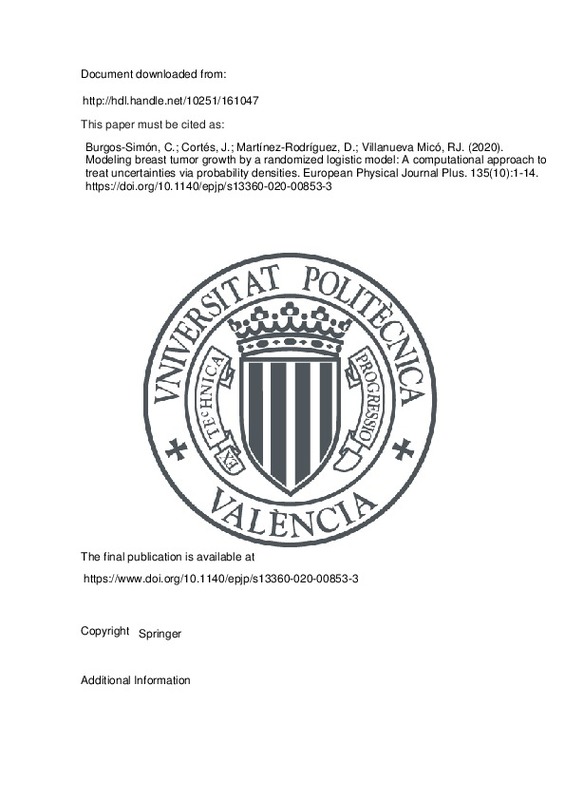D. Delen, G. Walker, A. Kadam, Predicting breast cancer survivability: a comparison of three data mining methods. Artif. Intell. Med. 34(2), 113–127 (2005)
H.-C. Wei, Mathematical modeling of tumor growth: the mcf-7 breast cancer cell line 16(mbe–16–06–325), 6512 (2019). https://doi.org/10.3934/mbe.2019325
N. Bellomo, E. de Angelis, Selected Topics in Cancer Modeling: Genesis, Evolution, Immune Competition, and Therapy (Springer Science & Business Media, Cham, 2008)
[+]
D. Delen, G. Walker, A. Kadam, Predicting breast cancer survivability: a comparison of three data mining methods. Artif. Intell. Med. 34(2), 113–127 (2005)
H.-C. Wei, Mathematical modeling of tumor growth: the mcf-7 breast cancer cell line 16(mbe–16–06–325), 6512 (2019). https://doi.org/10.3934/mbe.2019325
N. Bellomo, E. de Angelis, Selected Topics in Cancer Modeling: Genesis, Evolution, Immune Competition, and Therapy (Springer Science & Business Media, Cham, 2008)
N. Boyd, L. Martin, A. Gunasekara, O. Melnichouk, G. Maudsley, C. Peressotti, M. Yaffe, S. Minkin, Mammographic density and breast cancer risk: evaluation of a novel method of measuring breast tissue volumes. Cancer Epidemiol. Prevent. Biomark. 18(6), 1754–1762 (2009). https://doi.org/10.1158/1055-9965.EPI-09-0107
J.E. Joy, E.E. Penhoet, D.B. Petitti, Saving women’s Lives: Strategies for Improving Breast Cancer Detection and Diagnosis (National Academies Press (US), Washington, 2005)
J.V. Michalowicz, J.M. Nichols, F. Bucholtz, Handbook of Differential Entropy (CRC Press, Boca Raton, 2013)
C. Burgos-Simón, N. García-Medina, D. Martínez-Rodríguez, R.-J. Villanueva, Mathematical modeling of the dynamics of the bladder cancer and the immune response applied to a patient: evolution and short-term prediction. Math. Methods Appl. Sci. 42(17), 5746–5757 (2019). https://doi.org/10.1002/mma.5536
J. Manimaran, L. Shangerganesh, A. Debbouche, V. Antonov, Numerical solutions for time-fractional cancer invasion system with nonlocal diffusion. Front. Phys. 7, 93 (2019). https://doi.org/10.3389/fphy.2019.00093
S. Chakraborty, A. Debbouche, P.K. Roy, A mathematical modelling for treatment of HPV associated cervical cancer: Nk and effector t cell based control study. Nonlinear Stud. 27(2), 325–336 (2020)
D.-A. Botesteanu, S. Lipkowitz, J.-M. Lee, D. Levy, Mathematical models of breast and ovarian cancers. Wiley Interdiscip. Rev. Syst. Biol. Med. 8(4), 337–362 (2016). https://doi.org/10.1002/wsbm.1343
N.C. Atuegwu, L.R. Arlinghaus, X. Li, A.B. Chakravarthy, V.G. Abramson, M.E. Sanders, T.E. Yankeelov, Parameterizing the logistic model of tumor growth by DW-MRI and DCE-MRI data to predict treatment response and changes in breast cancer cellularity during neoadjuvant chemotherapy. Transl. Oncol. 6(3), 256–264 (2013). https://doi.org/10.1593/tlo.13130
H. Enderling, M.A. Chaplain, A.R. Anderson, J.S. Vaidya, A mathematical model of breast cancer development, local treatment and recurrence. J. Theor. Biol. 246(2), 245–259 (2007). https://doi.org/10.1016/j.jtbi.2006.12.010
E. Allen, Modeling with Itô Stochastic Differential Equations, vol. 22 (Springer Science & Business Media, Cham, 2007)
D. Nualart, The Malliavin Calculus and Related Topics, vol. 1995 (Springer, Berlin, 2006)
R.C. Smith, Uncertainly Quantification: Theory, Implementation, and Applications. Computational Science & Engineering (SIAM, Philadelphia, 2013)
M.-C. Casabán, J.-C. Cortés, J.-V. Romero, M.-D. Roselló, Probabilistic solution of random SI-type epidemiological models using the random variable transformation technique. Commun. Nonlinear Sci. Numer. Simul. 24, 86–97 (2015). https://doi.org/10.1016/j.cnsns.2014.12.016
M.-C. Casabán, J.-C. Cortés, A. Navarro-Quiles, J.-V. Romero, M.-D. Roselló, R.-J. Villanueva, A comprehensive probabilistic solution of random SIS-type epidemiological models using the random variable transformation technique. Commun. Nonlinear Sci. Numer. Simul. 32, 199–210 (2016). https://doi.org/10.1016/j.cnsns.2015.08.009
M. Ezechiáš, T. Cajthaml, Receptor partial agonism and method to express receptor partial activation with respect to novel full logistic model of mixture toxicology. Toxicology 393, 26–33 (2018)
F. Brauer, C. Castillo-Chavez, C. Castillo-Chavez, Mathematical Models in Population Biology and Epidemiology, vol. 2 (Springer, Berlin, 2012)
C. Salas-Eljatib, A. Fuentes-Ramirez, T.G. Gregoire, A. Altamirano, V. Yaitul, A study on the effects of unbalanced data when fitting logistic regression models in ecology. Ecol. Ind. 85, 502–508 (2018)
V.G. Vaidya, F.J. Alexandro Jr., Evaluation of some mathematical models for tumor growth. Int. J. Biomed. Comput. 13(1), 19–35 (1982). https://doi.org/10.1016/0020-7101(82)90048-4
E.C. Pielou, An Introduction to Mathematical Ecology (Wiley-Inter-science, New York, 1969)
J.G. Skellam, Random dispersal in theoretical populations. Biometrika 38(1/2), 196–218 (1951)
P.-F. Verhulst, Notice sur la loi que la population suit dans son accroissement. Corresp. Math. Phys. 10, 113–126 (1838)
T.T. Soong, Random differential equations in science and engineering (Academic Press, 1973). ISBN 978-0-12-654850-1
J.-C. Cortés, A. Navarro-Quiles, J.-V. Romero, M.-D. Roselló, (cmmse2018 paper) solving the random Pielou logistic equation with the random variable transformation technique: theory and applications. Math. Methods Appl. Sci. 42(17), 5708–5717 (2019). https://doi.org/10.1002/mma.5440
A. Worschech, N. Chen, A.Y. Yong, Q. Zhang, Z. Pos, S. Weibel, V. Raab, M. Sabatino, A. Monaco, H. Liu et al., Systemic treatment of xenografts with vaccinia virus glv-1h68 reveals the immunologic facet of oncolytic therapy. BMC Genom. 10(1), 301 (2009). https://doi.org/10.1186/1471-2164-10-301
H. Caysa, S. Hoffmann, J. Luetzkendorf, L.P. Mueller, S. Unverzagt, K. Mäder, T. Mueller, Monitoring of xenograft tumor growth and response to chemotherapy by non-invasive in vivo multispectral fluorescence imaging. PLoS ONE 7(10), e47927 (2012)
The MathWorks Inc. (2020) Particle Swarm Optimization. https://es.mathworks.com/help/gads/particleswarm.html
L. Devroye, Nonuniform random variate generation. Handb. Oper. Res. Manag. Sci. 13, 83–121 (2006)
T. Weise, Global optimization algorithms-theory and application. Self-Published Thomas Weise (2009)
N. Khemka, C. Jacob, Exploratory toolkit for evolutionary and swarm-based optimization. Math. J. 11(3), 376–391 (2010). https://doi.org/10.3888/tmj.11.3-5
Y. Khan, H. Vazquez-Leal, Q. Wu, An efficient iterated method for mathematical biology model. Neural Comput. Appl. 23(3–4), 677–682 (2013)
E.F.D. Goufo, Y. Khan, Q.A. Chaudhry, Hiv and shifting epicenters for covid-19, an alert for some countries. Chaos Solitons Fractals 139, 110030 (2020)
[-]







![[Cerrado]](/themes/UPV/images/candado.png)


